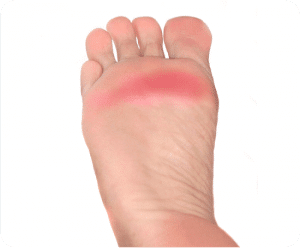Metatarsalgia is the term used to describe pain in the forefoot. The metatarsal bones bear the greatest part of the body’s weight when we are 
Metatarsalgia occurs most frequently in the middle-aged, and is a common side effect of weight gain. A sedentary lifestyle is also a risk factor, as is walking with a poor gait, which causes the foot to bend and flex incorrectly, putting pressure in the wrong places.
Tips to Treat Metatarsalgia
Metatarsalgia must be treated by addressing the biomechanical processes that have created the problem, and by treating the symptoms to reduce pain and prevent recurrence.
1. Elevate the arch of the foot. Orthotic devices or Custom Arch Supports can be used to great effect, especially when they are designed for this problem. Visiting a specialist store such as Foot Solutions will allow you to get professional advice to find the best solution for your feet.
2. Correct gait. Bad posture and walking in a way that puts pressure on your joints can be very stressful on your feet and can cause problems such as Metatarsalgia and fallen arches. Ensure your feet are well supported at all times by wearing good quality shoes & arch supports that fit, and work to correct any problems with your gait as this will prevent problems from recurring.
3. Reduce weight. If you are overweight, your feet have to work much harder to carry you around all day long. Getting your weight under control through healthy eating and exercise will mean that there will be less pressure on your feet, and problems such as Metatarsalgia will be much less likely to cause you pain and discomfort.
4. Treat calluses. Regularly soaking your feet and using a pumice stone or foot file to remove the areas of hardened skin should help to treat the calluses that are caused by Metatarsalgia. Giving yourself regular pedicures should help to keep the problem at bay, but if you experience difficulties, consult a chiropodist or podiatrist. Note: Diabetics & people with poor circulation should always consult their doctor/pharmacist for advice on foot treatment plans.
5. Wear the right shoes. Many conditions that are painful and problematic for your feet are caused by wearing shoes that do not fit your feet properly. Whether you are wearing unsupportive shoes all day at work, or you’re exercising in shoes that aren’t good enough to absorb shocks and protect your feet from damage, it’s worth addressing this as soon as possible to keep your feet in great condition.
Finding The Perfect Shoes For You in the UK

































